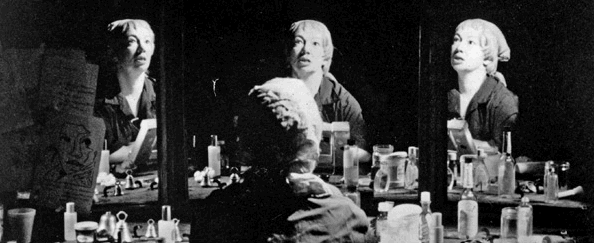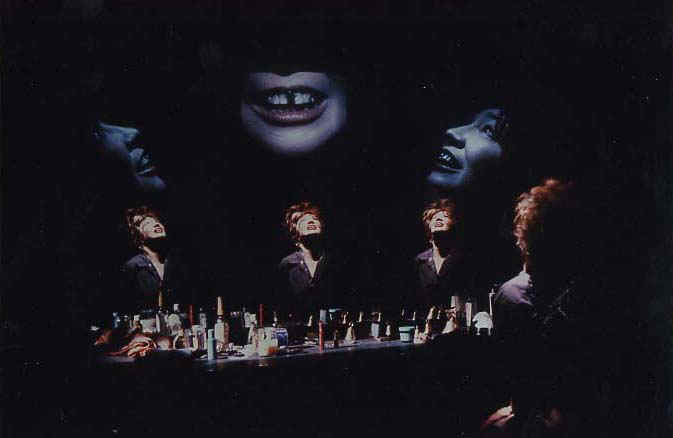|
The video revolution has been a long time coming, and by now most people have an inkling what to expect. Broadcast television, cable, VCRs, and video games have prepared us for the technological and commercial possibilities of the medium, its convenience as a conveyer of information, and its adaptability to arcade entertainment. But what is the artistic potential of video? What doors to the imagination can it unlock that remain closed to other media? A few experimentalists are exploring the aesthetic innovations new technology makes possible, and the results – Jean-Luc Godard’s
Numero Deux, for example, or the appearances of performance artist Laurie Anderson – are exciting, indeed. Joining this cadre of pioneers is the New York-based theater collective Mabou Mines, whose hour-long piece
Hajj marks one of the first attempts to integrate video and live performance.
Shown in open rehearsals at the Performing Garage in New York and performed as a work in progress at the American Film Institute’s National Video Festival last June,
Hajj is a athree-way collaboration. Based on a poem by Lee Breuer, it is performed by Ruth Maleczech, and the video elements are conceived and designed by Craig Jones, who, although not a Mabou Mines member, has worked on video projects
(The Lost Ones, B. Beaver Animation) and live production
(Wrong Guys) with the collective in the past. Breuer and Maleczech are founders of Mabou Mines, whose productions over the years have varied as widely as the interests of its members. The shows range from exquisitely acted renditions of Samuel Beckett’s minimalist prose, to original compositions by Breuer, to JoAnne Akalaitis’s multimedia “history of nuclear power,” called
Dead End Kids. In experimental theater circles, the name “Mabou Mines” conjures up bravura performance supported by high-tech stagecraft – the thinnest of threads to tie together the company’s diverse repertoire, but in practice a sturdy trademark.
Of the Mabou Mines members, Breuer has the strongest fascination for gadgetry, possibly because he is one of the few who is not an actor. As both a writer and director, Breuer applies his verbal talents and his technological curiosity to what he calls “performance poetry” – theater that suspends conventional dramatic elements of action, suspense, plot, and psychology in order to achieve the dreamy, unfettered evocativeness of a poem. With typical California-hipster flair, Breuer likens the process of staging poetry to driving a standard-shift car: “The motor revs higher and time goes slower and the power is greater and you use a hell of a lot more gas. And then we get to the poem itself. We get to that great gear of art called ‘neutral,’ where the motor mind can rev to infinite tach, where pistons have fantasies of a thousand miles an hour before they throw their rods and blow their gaskets, and the vehicle of time never moves at all.”

This may sound like perfervid conceptual-art theorizing, but in viewing Hajj, one understands the lyricism in Breuer’s abstruse analogy. The actress Maleczech sits down at a vanity table, her back to the audience. She faces a triptych of tall, ornately framed mirrors and begins to apply an elaborate makeup. When she reaches for a hairpiece, a video monitor suddenly reveals itself behind one of the mirrors and a closed-circuit camera zooms in on the hairpiece.
As she continues putting on her makeup, monitors behind the other two mirrors flicker on, picking up similarly specific images – a necklace, the smoke from her cigarette. The actress murmurs the text (picked up by a high-powered body mike) as the screen images float alongside her reflection in the mirror, and these are soon joined by another layer of imagery. Filmed sequences showing a child on the lap of an old man and a truck driving through a barren landscape are superimposed on closed-circuit images of Maleczech’s face or objects on the makeup table. As suddenly and magically as they appear, the video pictures periodically drop out altogether, leaving a woman alone at the mirror with her reflection instead of – her dreams? her memories? her soul?
The text of Hajj describes a metaphysical journey to pay off a debt to someone who has already died. But the creators chose not to illustrate the poem literally. “We didn’t want to cop to a narrative,” as Maleczech puts it. Instead, they sought to reproduce the emotional and mental state of the person making the journey – something much more fluid and elusive. “We started out with a very simple format,” says Breuer. “Ruth live was time present. Ruth in closed-circuit was mental association; in other words, she would pick up an object, and you’d see what she was thinking about. And the prerecorded tape was her memory. It’s as if you’re eating dinner, and suddenly you stare at the plate. In our terms, the plate would be on closed-circuit and come into close-up. Then the plate would suggest a memory, and you’d see an image of the memory inside the plate.”
The collaborative conception of the piece meant that it was up to Maleczech to supply the “memories,” and she chose a trip she took as a child with her father in an army truck as the basis for the prerecorded video. Videographer Craig Jones, meanwhile, came up with the idea of setting the piece at a vanity table, using two-way mirrors to make the video a metaphor for observing oneself. “We also had in the back of our minds the Dorian Gray idea that the image of oneself changes in relation to one’s spiritual position,” says Breuer.
Maleczech undergoes three transformations in the piece as her makeup changes from the clear complexion of a child to that of a gypsyish middle-aged woman to a latex mask representing an old man. The progression of her artificial aging relates almost subliminally to the trip depicted in the video, and they both relate tangentially – poetically – to Breuer’s text. “The best way to look at it,” he says, “is as a pilgrimage into yourself, the child traveling toward – who knows – death, spiritual revelation. We wanted to equate that with the actor’s pilgrimage of going into oneself through playing characters.”

This is not Mabou Mines’ first involvement with video. In 1981 video artist Doris Chase made a 30-minute tape called
Lies that Breuer wrote and Maleczech performed; the amusing conceit of the piece was that the actress would recite a statement (presumably false) and a price – the cost of each “lie” – would flash on the screen, looking for all the world like the low, low price of mail-order steak knives in a late-night television ad. Although it was a good exercise, Breuer ultimately found the canned aspect of pure video unsatisfying. “The best thing I learned was that the true representation of my writing had to have a live element.”
The best thing about Hajj, in fact, is that live element. For all its sophisticated grasp of video technique, the piece derives its strength and simplicity from Maleczech’s performance. An unprepossessing woman offstage, Maleczech is an almost disturbingly powerful actress. Her voice is even, her gestures meticulous and understated, but under the lights she becomes a witch harboring secret, unpredictable forces. Her wide, alert face expresses an inscrutable calm.
In Hajj, when she purrs into the telephone, “I’ll pay you the money, man, I’m not trying to rip you off,” she projects easygoing humor, stifled sorrow, and a frightening, exotic quality all at once. And, sitting silently in front of the mirrors, she really does make you think that she is summoning from the depths of her soul the images that appear on the glass. With such an electrifying yet evanescent presence at its core,
Hajj never becomes a purely visual work or a purely verbal one, but remains stubbornly theatrical. It is a moment of primitive magic, a performance poem in which “the vehicle of time never moves at all.”
This live essence is what distinguishes Hajj from other video pieces. Breuer compares the work to the excerpts from Robert Ashley’s “video opera”
Perfect Lives (Private Parts), which John Sanborn and Kit Fitzgerald have exhibited, while Maleczech cites Laurie Anderson’s performances and Joan Jonas’s
Organic Honey’s Vertical Roll. None of these, however, utilizes live performance and closed-circuit video and prerecorded video. The fact that
Hajj uses all three is the source of its originality, but it’s also the source of the piece’s almost impossible technical demands.
Breuer and Maleczech have had to rehearse the performance with rough cuts of prerecorded video, which means mixing the video
live. “Every time you change the timing of something, you have to reedit,” says Breuer, “and for just a few minutes that can run $3,000. It’s mind-bogglingly expensive.” Lighting also becomes a problem. “You have to have enough light so that the live photography is sharp and clear and color-true,” Maleczech points out, “but you can’t have so much light that the video fades out. And you have to be able to isolate the dramatic element.” The solution that they found works best is to use tiny localized spotlights, and, with better cameras, they have been able to use less and less light.
Equipment, of course, is the biggest headache. Hajj is designed for an electronically synchronized system of three closed-circuit cameras and three monitors (a 30-inch in the center and a 25-inch on either side) attached to a special-effects generator that can darken the monitors when not in use so they “disappear” behind the mirrors. Needless to say, a company like Mabou Mines, which has existed for 14 years on off-off-Broadway-sized budgets, is not likely to own such equipment. And experimental theater is not even as lucrative as low-budget filmmaking, so the group can hardly attract investors with the promise of triple dividends. “When you give money to Mabou Mines,” says Maleczech, “the way it works is you don’t get it back.”
Without backing, they had to begin work with a Betamax and one monitor, borrowing whatever equipment they could find and editing whenever someone offered them free studio time. But in order to finish creating and rehearsing
Hajj in time for the planned New York opening at the Public Theater in April, they are almost entirely dependent on the willingness of the Sony Corporation to loan them a truckload of equipment for at least eight weeks. And if the work is to have a life after that, it will have to tour places already equipped with video facilities. Luckily, the increase in university media centers makes that a good possibility.
If Hajj’s combination of video and live performance is unique in contemporary theater, suggests Breuer, it’s because finding the facilities is so difficult.
He is only half joking. “We must have spent ninety percent of the time trying to borrow equipment and about ten percent actually making the piece.” Considering the cost and the complicated design of the technology, it is surprising that the use of video in
Hajj is so restrained, so delicate. Why not throw in some computer-generated graphics and a few snazzy quick cuts while the resources are at hand? “The piece shouldn’t be seen to be about technology,” explains Maleczech. “This is an all-out attempt to stage a poem and leave it a poem, to create the understanding a poem creates.”
Now there’s an imaginative approach to video.
American Film, January-February 1983
|